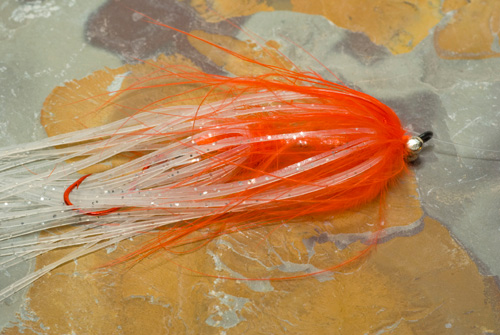The Squidro
Designed by Scott Howell

Hook: Up eye steelhead #4/0-#2/0
Thread: Hot Orange or Fire Orange 6/0
Leader Loop: Stiff Dacron backing, gel-spun braid or knottable bite tippet
Tag: Silver Mylar
Butt: Hot orange seal’s fur, African goat or suitable synthetic
Rear Legs: Pearl with silver flake sili legs or Squid Pearl Steely Legs
Rear Dubbing Ball: Hot orange seal’s fur, African goat or suitable synthetic formed in front of the rear legs
Body: Silver Mylar
Body Collar: Hot orange seal’s fur, African goat or suitable synthetic
Front Legs: Pearl with silver flake Sili legs or Squid Orange Steely Legs
Collar: Fluorescent flame or light flame orange marabou
Eyes: Dumbbell eyes, silver
Scott Howell is a renowned steelhead guru, Oregon guide and innovator amongst the steelhead fraternity. Along with fly fishers such as Ed Ward, Scott has influenced the design of many steelhead patterns today, particularly Intruders.
Frustrated after watching his Intruders natural ostrich and rhea hackles mauled and reduced to tatters by aggressive steelhead and dollies Scott began a quest for a durable alternative. The substitute had to be long lasting, readily available and easy to work with. Silicone or sili legs proved to be the perfect substitute. The Squidro, a rubber legged Intruder, was born. A creation, that in many ways suggested an assortment of primary steelhead prey.
Scott sampled other synthetic leg materials such as round rubber hackle and Stretch Floss but they were either too stiff or in the case of Super floss too supple. Under tension and influence of the current supple materials tuck flush, turning Intruders into nothing more than slender leeches.
Silicone legs have the right balance of mobility and stiffness coming alive in the current. A smorgasbord of color options was also at Scott’s disposal. He could now create large, durable, easy to cast, animated patterns capable of triggering an instinctive response from returning steelhead in all manner of conditions, good and bad.
Sili legs are not new material. They have been popular for years with saltwater and bass tyers. Scott has begun supplying his own unique steelhead blend of sili leg called Steely legs. Steely Legs can be purchased on line through Scott’s website, along with a variety of unique steelhead centric products and materials.
Scott ties his Squidro’s in three unique series:
-Seafood Series-Tied in natural pastel ocean flavoured colors-white, orange, pink and pearlescent. Seafood Squidros are intended to suggest one of the steelheads primary food sources, squid.
-Winter Series-Winter Squidro’s are large, over six inches. They feature large dumbbell eyes to help slice through deep cold flows and are dressed in fluorescent pink, hot orange and purple. Proven colors in Scott’s words that, “Work in grubby water.”
-Summer Series-Designed to produce in low clear summer flows. Summer Squidro’s are smaller and bred from a sombre natural palette.
A Squidro’s legs are tied in along the sides of the fly in front of large scruffy dubbing balls fore and aft to both keep the legs away from the body and create a hydrodynamic disturbance to animate the fly. About half a hank or roughly one dozen legs per side. Use wide tying thread as narrow diameters such as 8/0 can sever the leg materials. Form a solid thread base then attach the legs using loose controlled wraps. Massage the legs into position and then tighten to secure.
When building the front section Scott begins by forming, loading and spinning dubbing loop at the front of the body at the wire return of the hook eye. He then holds the dubbing loop back and ties in the legs on both sides of the shank so they protrude forward in front of the hook eye. The dubbing loop is wound behind the legs, done correctly only the doubled thread from the dubbing loop remains. The thread loop is then brought through the sili legs and tied off.
Most Intruders today are tied on large stout steelhead irons. Scott recommends #3/0 or #4/0 to provide a large enough foundation on which to construct the fly. Upon completion, use a pair of side cutters to remove the hook bend. Large steelhead hooks are not always easy to find but Scott assures me he will soon have a solution.
Modern Intruders feature a short stiff loop of Dacron backing, gel-spun braid or knottable bite tippet attached to the rear of the shank prior to tying. A small octopus hook is attached using a loop to loop connection. Scott prefers Dacron and will soon have dyed backing available through his site to help you color coordinate your Squidro’s and Intruders. This system is intended to facilitate quick and easy hook changes without sacrificing the fly.
The short loop is a recent innovation on the Intruder timeline. Original Intruders featured a short loop of stiff backing or mono tied in at the rear of the shank. The leader was passed through the hook eye, along the back of the fly through the small loop at the rear of the shank and a short length of hook shank diameter wide tubing. Once threaded, the hook was tied on. The hook eye was then stabbed into the tubing which in turn was stabbed onto the hook shank where the bend was removed. Hook changes are a breeze. Scott still prefers this external tube fly-like set up.
Once Scott’s Squidro is engulfed by a steelhead it slides up the leader, out of harm’s way. Consider using this approach on your next Intruder or Squidro.
For more information on Scott's Squidro series please check out his You Tube segment.
To view the rest of this article, please login or join now for free!
|



